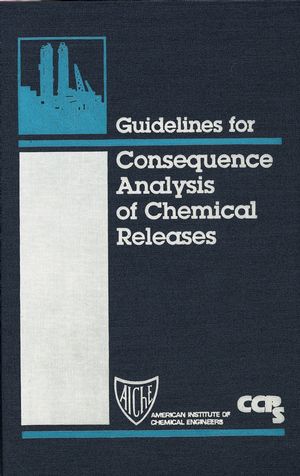Guidelines for Consequence Analysis of Chemical ReleasesISBN: 978-0-8169-0786-1
Hardcover
346 pages
March 1999
 This is a Print-on-Demand title. It will be printed specifically to fill your order. Please allow an additional 15-20 days delivery time. The book is not returnable.
|
||||||
Acknowledgments.
1989 CPQRA Guidelines Acknowledgments.
Acronyms.
Chapter 1. Introduction.
1.1. CPQRA Definitions.
1.2. Consequence Analysis.
Chapter 2. Source Models.
2.1. Discharge Rate Models.
2.1.1. Background.
2.1.2. Description.
2.1.3. Example Problems.
2.1.4. Discussion.
2.2. Flash and Evaporation.
2.2.1. Background.
2.2.2. Description.
2.2.3. Example Problems.
2.2.4. Discussion.
2.3. Dispersion Models.
2.3.1. Neutral and Positively Buoyant Plume and Puff Models.
2.3.2. Dense Gas Dispersion.
Chapter 3. Explosions and Fires.
3.1. Vapor Cloud Explosions (VCE).
3.1.1. Background.
3.1.2. Description.
3.1.3. Discussion.
3.1.4. Example Problems.
3.2. Flash Fires.
3.3. Physical Explosion.
3.3.1. Background.
3.3.2. Description.
3.3.3. Example Problems.
3.3.4. Discussion.
3.4. BLEVE and Fireball.
3.4.1. Background.
3.4.2. Description.
3.4.3. Example Problems.
3.4.4. Discussion.
3.5. Confined Explosions.
3.5.1. Background.
3.5.2. Description.
3.5.3. Example Problem.
3.5.4. Discussion.
3.6. Pool Fires.
3.6.1. Background.
3.6.2. Description.
3.6.3. Example Problem.
3.6.4. Discussion.
3.7. Jet Fires.
3.7.1. Background.
3.7.2. Description.
3.7.3. Example Problem.
3.7.4. Discussion.
Chapter 4. Effect Models.
4.1. Dose-Response and Probit Functions.
4.1.1. Dose-Response Functions.
4.1.2. Probit Functions.
4.1.3. Example Problem.
4.2. Toxic Gas Effects.
4.2.1. Background.
4.2.2. Description.
4.2.3. Example Problems.
4.2.4. Discussion.
4.3. Thermal Effects.
4.3.1. Background.
4.3.2. Description.
4.3.3. Example Problems.
4.3.4. Discussion.
4.4. Explosion Effects.
4.4.1. Background.
4.4.2. Description.
4.4.3. Example Problem.
4.4.4. Discussion.
Chapter 5. Evasive Actions.
5.1. Background.
5.2. Description.
5.3. Example Problem.
5.4. Discussion.
Chapter 6. Modeling Systems.
Reference.
Appendix: CD ROM.
Glossary.
Index.



